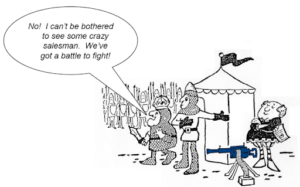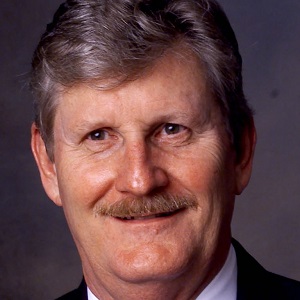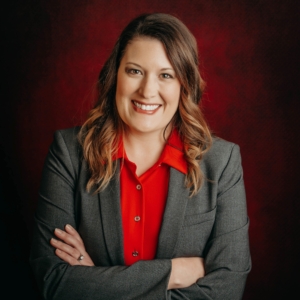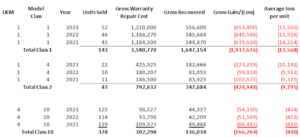What Would You Have Done

Thomas Barry – ‘Tom’ has long taken to heart the fortuitous occasions and high value of being prepared and focused when the opportunity to be considered, called upon, and compete align. This was a necessary mindset fostered and forged when seeking to make the youth baseball, soccer, hockey, and chess tournament teams while growing up in both Massachusetts & New Jersey having moved several times. He makes his first blog post for Learning Without Scars with, “What Would You Have Done?”
Attending High School in both MA & NJ, illuminated the precept that demonstrating your value was only evidenced by your repeatedly proven capacity to generate stellar results within those brief moments of timely relevance. As does earning a spot on the Soccer & Baseball Teams within new schools with 5,000+ students. The application of this internalized set of motivators has proved useful and beneficial as it has translated into a long list of both individual and corporate leadership business awards. Recognitions, bestowed for sales, marketing, share of market, and comprehensive KPI metric performances repeatedly recognized by world leading OEMs, heavy equipment stocking distribution businesses, as well as governments on Local, State, and Federal levels; for National, North American, and Global Sales and Export performances.
A Graduate of the University of California, Berkeley, there… Tom applied for and was accepted into a highly selective Independent Studies degree program within the College of Letters & Science while also a member of the PAC10 Cal Baseball Team. His focus was professional sales and as such was permitted to take coursework from all 14 UCB campus colleges including 2 years of MBA studies in the Principles of Corporate Finance, Engineering, Business Law, Accounting, Statistics, Computer Science, Political Economies of Industrialized Nations, Sentential Calculus, and the completion of a culminating Senior Thesis which earned an ‘A’.
Tom and his wife Eileen met in High School and are now married 36 years and reside in Columbus, OH. Their two adult sons were very active in Travel Soccer & Tennis which initiated a great band of parents that routinely gather for the next Ohio State Buckeye Football or Columbus Crew Soccer Games!
You can find Tom on LinkedIn.
A true-life heavy construction equipment sales presentation story shares insight of contrasting styles of differentiating value propositions.
Several of the competing OEM distributorships’ senior leadership emerged from behind their desks to present a product of three (3+) of the world’s leading competitive OEMs to my unit.
Unique styles and approaches collided in a high-profile opportunity wherein a purchase of a 147,000 lbs. excavator is on the table to be selected by the winner ‘Bill’ of a State Government low bid public service energy project!

Preamble: Within a typical sales career launch… many representatives will start off at a level of skillset capacity descriptively referred to that of Unconscious Incompetence. If you’re slow to embrace and internalize key precepts available from training… you’ll likely be lacking at your needed industry skills, and you will often not even know it or know why. Nevertheless, with some initiative and persistent engagement, you’ll advance to a level of Conscious Incompetence wherein you’ll perform under par, and you’ll be aware that you’re not as good or as effective as desired from yourself and others. Self-awareness is needed!
As you practice, drill, and rehearse your early skillset, pivotal personality traits, product knowledge, and practiced presentation choice of words nuances, you’ll start to notice and appreciate marked strides towards improvement. The results will often equate to some level of competence along with periodic moments of success that fuel an onwards and upwards spirit to endeavor towards continuous improvement!
Continue to hone your skills and you’ll reach a level of Conscious Competence…You’ll be prepared and skilled and self-aware of such. Down the road…staying the course and with a mind to continuous improvement… and striving for excellence… the phase of your career wherein you attain Unconscious Competence awaits. Therein is the stage at which you can earn self-satisfaction and rewarding recognition levels familiar to many that enter the arenas of sports. More importantly, you’ll find that the professional field of sales is a lot of fun and full of gratifying moments of satisfaction of helping to uniquely solve customers’ problems! The journey of taking a Brand Mark to another level of Brand __________!
This capacity for professional growth and career satisfaction will be a function of your capacity to act with sincerity, to do more for your customers than anybody else is willing to wield to deliver, so that they and their opportunities can be as successful as possible!
As I waited in the entry foyer… of an existing customer’s visitor’s chair that morning, I was greeted by the President’s Office Manager, whom I knew quite well of this fast-growing construction firm; on the matter of a recently secured heavily competitive bid for a large public service energy project. The very familiar banter which was commensurate between us was suspended as the President emerged from his office and spoke with an energetic/pleasant business tenor…
“Busy day Tom, I have no time for pleasantries… I’d like to meet with you today…I’ve got a meeting set already to meet with (OEM Distributor Competitor #1) in 15 minutes from now – this morning… who, by the way, isn’t happy that you sold me the last 20 machines I’ve purchased. They are embarrassed and have assured me that their final pricing and enthusiasm expressed is going to reflect that point to say the least. I’m also meeting with (OEM Distributor Competitor #2 & #3) this afternoon as they each related to me this order is going to be theirs…that should be interesting. Do you want to meet me before I meet with (OEM Distributor Competitor #2 & or #3)?”
I replied, thank you for asking but no thank you Bill, … I’ll be pleased to take the last appointment of the day. I’ll catch up with you at 5:00PM, if that works, as I doubt that my perspective and comments will need to take very long…and I can answer any questions you may have that stemmed from your prior meetings.
Bill replied: “OK… Sounds good Tom, see you then.”
Upon my return, I arrived ten minutes early and soon was summoned to sit across from the Contractors’ President’s desk to relate the following with a high degree of matter-of-fact confidence. “Bill, as always thank you for your time to speak with you and for the opportunity to be compared so that our value can be identified – as always that is highly appreciated! Bill as you are keenly aware… you’re buying a tool for a job. The tool you need for this job is very soon to start am I correct? Bill replied Yes!
I added, the importance of this job is enormous. Everyone will be watching, and this will likely be the most important job in the history of your company…am I correct in saying that? Bill replied ‘Yes’! If you would be so kind Bill, please share just a bit about your project… is it the same as what I’ve heard (he knew I assisted with his bidding team of engineers)? Indeed, it was the same.
I summarized and related OK Bill, thank you for that feedback as it is largely the same specs as I had recalled from my prior meeting notes. {As I was about to begin my presentation comments, Bill interrupted me and stated} …
“Tom your proposal to me is at $675,000 for your excavator package vs. Competitor #1 at $545,000 and Competitor #2 is at $475,000 and Competitor #3 is at $425,000 with an additional caveat of “Make me an Offer” comment from their V.P. of Sales… who related that the factory is going to make sure that this deal is theirs! (Bill added) … ‘that has turned my head…Tom, you know I like you… so let’s keep this conversation about meat and potatoes because that is at least $250,000 we’re talking about.”
Thank you for that feedback, Bill… much appreciated. I took the liberty to stop by the facilities of Competitor #2 & #3 today. I drove through their equipment inventory yards as if I owned the place and despite some of the looks, I got, I took these pictures of their machinery, buckets, and excavator arm inventory positions on their respective grounds as I wanted to assess their capacity to support you considering the difficulty and importance of this project. We’re talking about very hard shale & dolomite seams that cannot be blasted as I recall from conversations with your estimators (I referred to them by names)!
Competitors #2 & #3 have just one bucket each in inventory… and that is only the ones already mounted onto their only inventoried excavator unit they are quoting you. They both have 65” soil bailing buckets installed – not matched for the early job phases. You’re going to need quick disconnects on the bucket couplers with a capacity to switch between at least 3 buckets so that you can maximize your productivity and reduce the amount of stone that will support the trench with the appropriate amount of stone bedding and backfill. You will likely be entertaining the prospect of even taking a 2nd longer arm for the excavation effort as this job is pulling triple boxes for safety requirements as you near the end. This shale you are excavating at the bottom of the trench will require a rock bucket that is a $55,000 item. Such bucket specs take 6 weeks to order and arrive if all goes well.
As to Competitor #2 & #3, offering… forget about the very close machinery specifications on brochures and the bucket issues which are significant…and the critical and hoped for parts and service support desired for a limited number of units present in the region, as compared to what you are already aware of and confident of with our support. Nobody knows Competitors #2 & #3 offer better than the guys who pitched you on it earlier today. As to Competitor #3, do you really want to consider owning a machine that costs over $400,000 wherein your opportunity to sell it when you’re done with this project has to include the line “Make me an Offer”? Bill, Competitor #2, hasn’t sold a single 75,000 lbs. or larger excavator in this State since the undercarriage wore out on their 100,000 lbs. excavator in 1,800 hours in the next county over which required the purchase of a new $45,000 undercarriage for the project to be completed. This isn’t a dozer working in high-speed reverse in sand and should never see that kind of wear. Their undercarriage and Triple Grouser Shoe specs are not only thinner, the material of their cast pins, bushings and pads are suspect at best. I have the name and number for that owner who would be only too happy to take your call to share that experience and his ‘lessons learned’ story.
As to Competitor #1, knowing they would be touting the glory of their Market Resale Value… I shared ‘keep in mind that 70 Units of this size excavator sold in our state over last decade’. ‘We have sold 56 of them…they have sold 14, and Competitors #2 & #3 haven’t sold any. Trade in Value – the opportunity to take it in trade on the next tool that you are required to have as this job concludes is of enormous relevance and importance. On that note we’re clearly a better designed machine and value as Competitor #1 doesn’t measure up and that is why we have sold 56 out of the last 70 units in this size class and 56 out of the last most recent 59 units sold. Again, you’re buying a tool for a specific job!’
Moreover, Resale Values for used equipment reflect all buyers’ preferences for new if they could afford them. For all such reasons our offer is the preferred machine of an informed buyer. Our confidence in keeping them in our fleet and supporting them includes our buying them as or if they make it to an auction. Our preference is to take them in trade… which would also position you to save on the taxes when buying new!
Just as you have purchased the last 20 machines from us, Bill, this next unit is the right decision… if and when you decide the unit is surplus to your next project needs and seek to pick up the next set of tools best matched, you will know that we have every interest to get that unit back for the right price that reflects the proven and established demand for that product in this State. The breadth of our product offering is well positioned to support your future needs. Note: I have 54 buckets in inventory for this size excavator along with that specialty rock bucket we discussed, numerous arm length choices, along with 16 of these excavator units in stock and in my rental fleet.
{NOTE: In what follows below is referred to as “An Alternate of Choice Closing Question}:
‘Bill, I know you have a quick start date for this project, so do you want the excavator delivered to the site by this Friday morning or afternoon or is Monday soon enough and which of the three buckets do you prefer to have mounted to start the job?’ (upon which time I shut my mouth and didn’t utter a word for the next 7 seconds of room silence) … Bill paused, sat back in his chair shook his head side to side and smiled, & then nodded… he stated “Wow… Tom! I did not think I would be saying this today… Monday morning… and the Rock Bucket so to have a wow factor at the Groundbreaking – there is going to be some Press & Dignitaries’ there” – he just purchased a $675,000 excavation package!
The satisfaction of a favorable outcome attained is a function of earning the customers endorsement of your opportunity to be compared in the process of addressing their needs. Gently leading that customer to identify and navigate the merit of your differentiating value proposition to a new and improved reality of added value – The Life-Cycle-Cost assessments of both ownership and time tested/trusted business relationships of Brand Insistence!
Did you enjoy this blog? Read more great blog posts here.
For our course lists, please click here.












